AFLW: North Melbourne star Kaitlyn Ashmore on journey of discovery after family secret revealed
Kaitlyn Ashmore is a proud Aboriginal woman but, for most of her life, she was unaware of her indigenous bloodline. The story of a family secret and a journey of discovery.
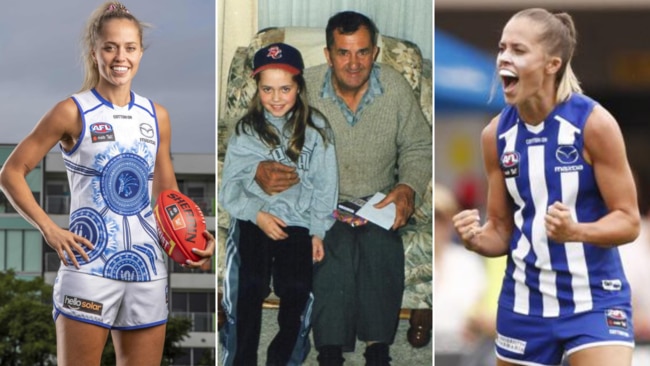
AFLW
Don't miss out on the headlines from AFLW. Followed categories will be added to My News.
Kaitlyn Ashmore’s grandfather kept a lifelong secret.
Lawrence was his name, but everyone called him “Mick”; Ashmore knew him as “Pa”.
Born in Creswick in regional Victoria into a large family with 10 brothers and sisters, Mick worked in a factory in Ballarat and was a man of few words — until it came to his beloved St Kilda Football Club, then he’d find a lot of words.
In 2011, he died after having a stroke.
Watch every match of the 2021 NAB AFLW Competition LIVE on Kayo. New to Kayo? Get your free trial now & start streaming instantly >
Thankfully, just before he passed away, he revealed to Ashmore’s father, Greg, what he’d never before felt able to tell anyone: he was Aboriginal.
Still, the secret stayed until about two years ago when Greg decided it was time for the family to discover more of their First Nations heritage and only in the past year has Ashmore herself started telling those close to her about her Aboriginal heritage.
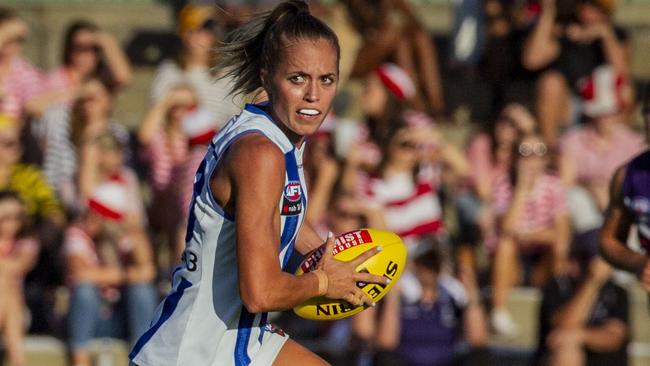
She has not spoken publicly about it until now.
“My Pa grew up in a world where indigenous people were frowned upon and he hid that part of himself,” the North Melbourne AFLW star says.
“I can’t even imagine that now.
“But because Pa hid it for so long, it’s been really hard to find out information and most of his brothers and sisters have passed away, too.
“We’re finding out information in dribs and drabs … we’ve only just started, but it’s a journey that is quite exciting.
“The more we find out, the more exciting it’s becoming.”
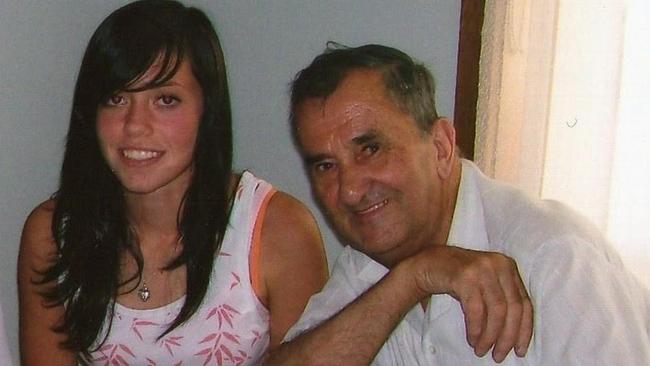
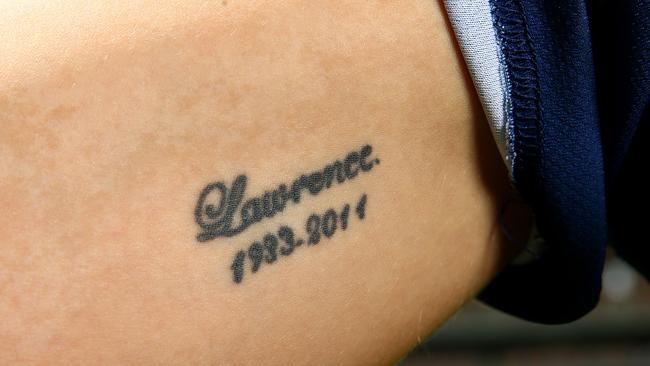
This is why the AFLW’s inaugural Indigenous Round means the world to the 29-year-old; it gives her the chance to pull on the Kangaroos’ symbolic jumper (which she helped design) on Saturday night before the Kangaroos play Carlton in Tasmania and stand proudly declaring her heritage: an honour and a privilege that was so wholly denied to her much-loved Pa.
What’s making her journey of discovery easier is the help from a family friend who is a proud indigenous woman and her teammate, Mia King, who is going through a similar experience.
King knows more of her Aboriginal heritage than Ashmore: that her great-grandmother, Ruby, lived in the Northern Territory and married a man called Lance and together they had a daughter called Maggie.
“Maggie was stolen from her backyard,” the 19-year-old midfielder says.
“Locals say that (Ruby) died of a broken heart not long after and Maggie never saw her mum again.

“Maggie endured quite a lot in her life. She was brought up in a mission camp on Crocker Island where she was taught the white ways and I think she really lost her heritage and identity there.
“Maggie was struggling … and so she had my dad, Martin, adopted. We only found out who my grandmother was two years ago and we contacted her but she was very sick and she passed away not long after and so I never met her.”
King is planning a trip to the NT – as soon as COVID borders and the AFLW timetable permit – with her sister so they can learn more about their family.
“My grandmother being a part of the Stolen Generation, but then my dad being adopted, we never learnt a lot about our heritage and our roots when we were growing up,” she says.
“We’re missing that part of our lives … to fill that hole in my life that I haven’t got to know, which will be special.”
In the lead-up to Indigenous Round, King’s found herself reflecting on all the trauma and hardship her family has faced, the effects of which are still being felt.
“To be able to celebrate our Aboriginal heritage and be proud of it is really important to me,” she says.
King knows her Mob – Jawoyn in the NT – but Ashmore is still on the path to discovering hers.
“I want to find my Mob and then find out more about them and I want them to teach me about the culture,” Ashmore says.
“When you find your Mob, there’s more a sense of belonging and that’s what I’m hoping for.
“I know there would be lots of other people in my situation and I think acknowledging it and accepting it is the first step.
“So hopefully if anyone is in the same situation that I am, they feel comfortable enough to say: ‘I am Indigenous’ and to just be proud of who they are.”
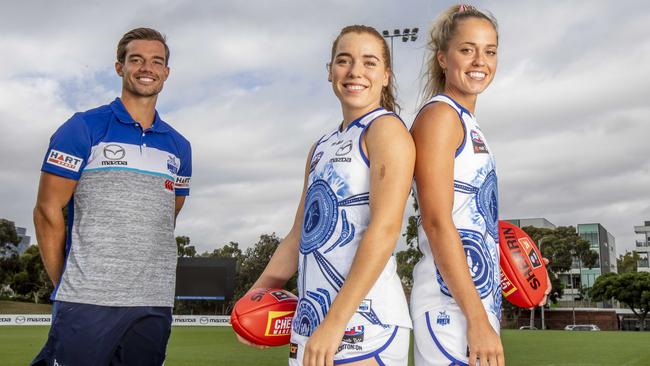
Kaitlyn Ashmore and Mia King helped design the Kangaroos indigenous jumper with the help of AFL midfielder Jy Simpkin and Kununurra artist, Emma MacNeill.
The intricate design centres around a kangaroo paw flower, where ‘U’ shapes represent the women, men and children who support the club, while kangaroo tracks complete the design in a nod to future generations following in our players’ footsteps.
In nature, the Kangaroo paw flower comes in many different colours, shapes and sizes, perfectly representing the women of our community, the women who are past, present and future; the women who share a passion for this sport regardless of their nationality, colour and identity.
Looking closer at the intricate patterns in the background, the 2021 Indigenous jumper reveals hands of support, a shield of protection as well as two initials, K.A and M.K.
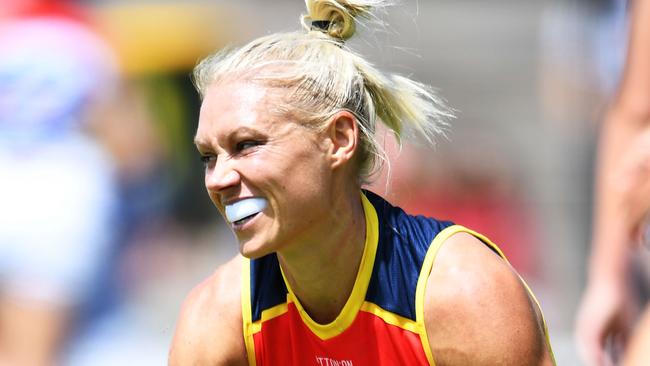
AFLW GREAT CALLS FOR INDIGENOUS PATHWAY
The AFL is in direct conversations with indigenous women footballers both past and present to better understand the needs of First Nations players as a way to increase their representation in elite footy.
Currently, only about 5 per cent of AFLW players are indigenous and the AFL’s head of women’s footy, Nicole Livingstone, said while no target had been set, the wish was to see an upturn in numbers.
In the AFL, about 11 per cent of the playing group are indigenous.
“We’ll continue to check in with players and try to understand what it is that they need to thrive (in the competition),” she said.
“We haven’t set a specific target that we would like to attract to the game, but the thing that we know about AFLW is that it is available as an option for everybody and I think we’ve proved that no matter who you are or where you come from, whatever your journey or your pathway is to AFLW, it is available to everybody.”
This weekend, the AFLW will celebrate its first-ever dedicated Indigenous Round.
As part of the dedicated round, all AFLW clubs will wear specially designed Indigenous Round guernseys, and on every playing surface will be painted the names of the Traditional owners of the land on which the game is being played.
Livingstone said the Woomeras youth program offered a pathway for First Nations footballers into the AFLW, which immersed them into an elite training environment, with the aim of increasing their football and personal development as well as leadership skills.
Clubs across the country are also investing in indigenous youth, with Essendon launching its Ngaalang Miya academy last year, while in South Australia, a high-performance football-based program for Aboriginal and Torres Strait Islander school students has been launched called the Tjindu AFL Max Academy.
“When we look at only 5 per cent being indigenous in the AFLW playing ranks, we hope that now they are seen on the telly week-in, week-out, it will be the catalyst for a lot more indigenous young girls to play the game,” Livingstone said.
“Given we’ve only been around for five years, we’re really starting to have an influence with young girls in terms of selecting AFLW football as the sport that they want to pursue and we’re seeing that now for people coming through the pathways.”
AFLW superstar Erin Phillips said the Indigenous Round was only a small part of what the league should be doing to support more First Nations players into the game.
“We need to keep developing pathways and academies,” the two-time AFLW best and fairest said.
“Hopefully we can get more indigenous players into our competition. They are fantastic athletes and play footy fantastically. When we were playing up in Darwin we got to see the talent up there, which is exciting.”
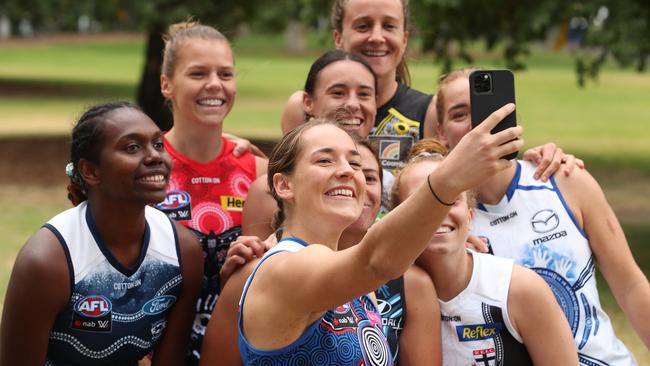
AFLW CLUBS UNVEIL INDIGENOUS ROUND JUMPERS
The AFLW will celebrate its first-ever league-wide Indigenous Round this weekend,
paying tribute to the contribution of First Nations people to the game and society more broadly.
The AFL’s head of women’s footy, Nicole Livingstone, said the dedicated round signalled the growth and development of the women’s league.
“We’ve had some games previously where teams have celebrated that contribution, but to have a full round for the first time, shows that maturity and development of the league,” she said.
“It is important for us as a league to make sure we can influence change in society … we think it’s important to represent the voices and the stories of indigenous women.”
As part of the dedicated round, all AFLW clubs will wear specially designed Indigenous Round guernseys, while AFL umpires will wear the 2020 Sir Doug Nicholls Round designed umpire uniform, which represents both Aboriginal and Torres Strait Islander communities.
And on every playing surface this weekend will be painted specialist artwork: on one side of the centre circle will be the names of the Traditional owners of the land on which the game is being played and on the other side, will be the traditional Aboriginal art symbol for woman painted in a coral colour.
The symbol sees two lines drawn either side of a cave-shaped semicircle.
Livingstone said the artwork was hugely symbolic.
“It’s really important for us to facilitate hearing the voices of women … it’s something that we’re really proud of and for this round in particular, it’s about us saying: ‘We are here, this is us’ and that indigenous art symbol represents that.”
Livingstone said a working group had been established to help determine how to best celebrate the first Indigenous Round and it included “very rich” conversations with First Nations across the clubs.
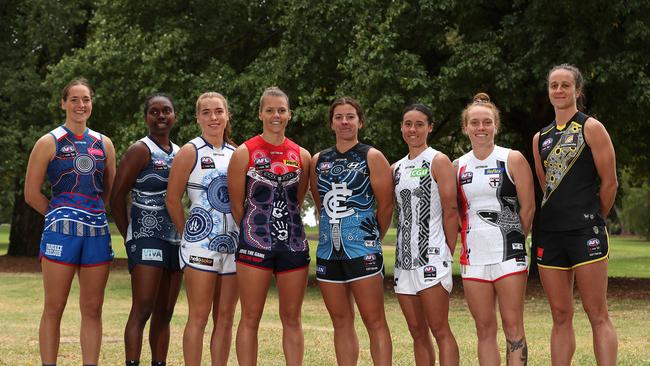
“We wanted to understand what their wishes were around representing them in the league that they play in,” she said.
“Aboriginal and Torres Strait Islander women have played a significant role in the development of our sport for many years, so we’re delighted that we’re able to recognise their contribution to our game in the first dedicated round this weekend.”
The Indigenous Round will kick off with a Friday night clash between Geelong and Richmond at GMHBA Stadium and conclude over in the West when the Eagles take on Gold Coast.
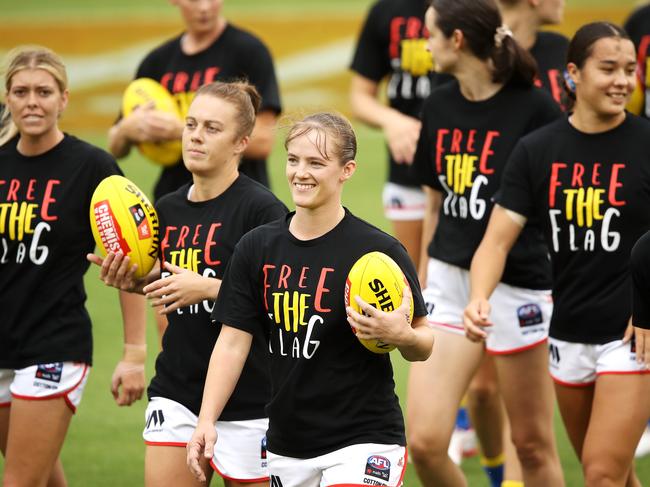
PIES SUPPORT ‘FREE THE FLAG’ PUSH
Collingwood’s women’s team has thrown its support behind the movement to free the Aboriginal flag from copyright restrictions and will wear Free the Flag T-shirts in pre-game warm ups for the rest of their AFLW campaign.
Players wore the special Free the Flag shirts during their pre-game warm-up on Saturday night at Marvel Stadium before defeating North Melbourne convincingly by 20 points.
In a statement, the club said: “Collingwood believes the Aboriginal flag should continue to play a unifying role with people and communities right across Australia.
“As such, the club supports the Free the Flag campaign.
“The Aboriginal flag is a national symbol and a central part of First People’s national identity.
“It was proclaimed as a National Flag of Australia in 1995 and should be free of licensing restrictions that currently limit its use.
“Collingwood’s AFLW program will show their support for the Free the Flag campaign as the club’s AFL and netball programs did in 2020.”
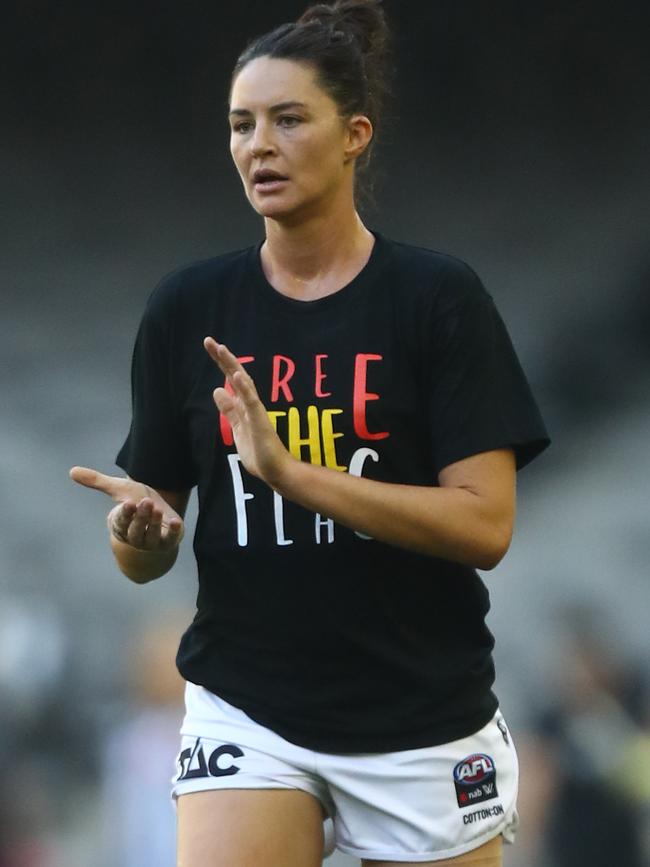
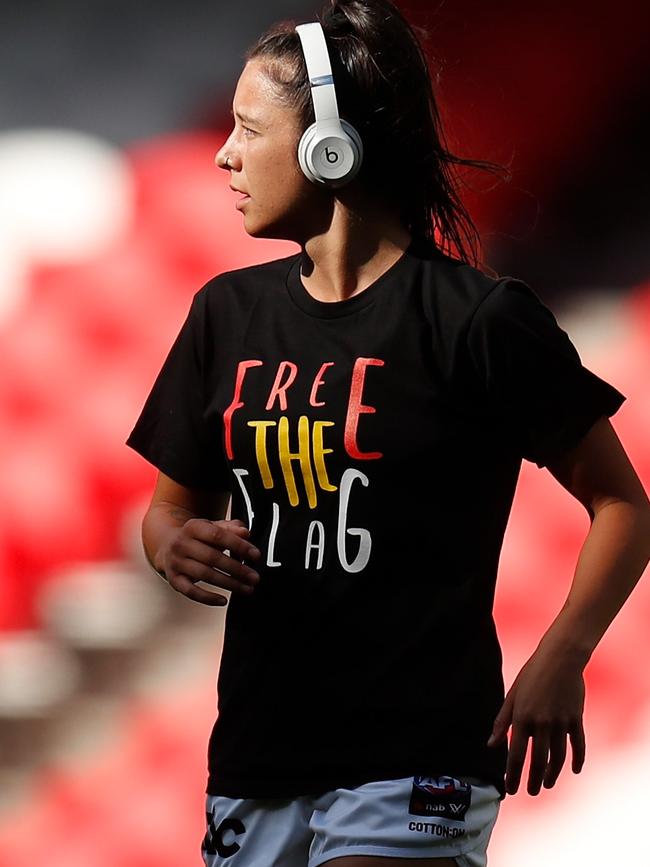
Both Brisbane and the Gold Coast have also announced their support for the campaign.
A Suns spokesman confirmed the club had worn the tops twice already this season and that the playing group would wear the shirts at their captain’s runs moving forward.
Other AFLW clubs are expected to announce over the coming days that they will also wear the Free the Flag shirts with the league celebrating its inaugural indigenous Round this weekend.
Proud Aboriginal woman and Collingwood forward Aliesha Newman said she was pleased the club was supportive of the Free the Flag movement.
“I grew up with the flag and it’s a very big part of my identity, so not having the opportunity to display that in the way that I would like is really disappointing and hopefully by wearing these tops we can spark a conversation to be able to get those laws changed,” she said.
“And the girls looked really good in the T-shirts.”
Newman said she was looking forward to the weekend’s league-wide indigenous Round.
“To be able to showcase our culture is something I will be extremely proud of walking out on the ground on the weekend.”
The unbeaten Collingwood will play Melbourne at Victoria Park on Sunday.
Collingwood’s Aboriginal and Torres Strait Islander Programs manager Debby Lovett echoed Newman’s words.
“Collingwood, through its AFL and netball programs, has been behind the campaign for some time now and it is a cause the AFLW program wants to share in,” Lovett said.
“We hope this momentum takes us closer to freeing the Aboriginal flag and returning it to its people.”




